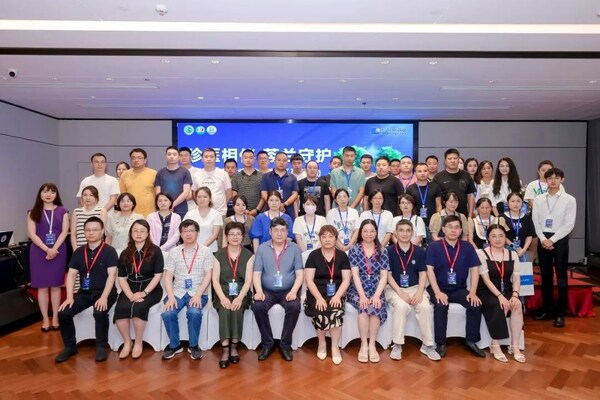预约演示
更新于:2025-03-20
Forsythin
连翘苷
更新于:2025-03-20
概要
基本信息
原研机构 |
非在研机构- |
最高研发阶段临床2期 |
首次获批日期- |
最高研发阶段(中国)临床2期 |
特殊审评- |
登录后查看时间轴
关联
100 项与 连翘苷 相关的临床结果
登录后查看更多信息
100 项与 连翘苷 相关的转化医学
登录后查看更多信息
100 项与 连翘苷 相关的专利(医药)
登录后查看更多信息
52
项与 连翘苷 相关的文献(医药)2025-02-04·Microbiology Spectrum
Phillyrin ameliorates DSS-induced colitis in mice via modulating the gut microbiota and inhibiting the NF-κB/MLCK pathway
Article
作者: Song, Zheyu ; Li, Tong ; Fu, Shoupeng ; Qin, Di ; Hu, Guiqiu
2025-01-01·Zhongguo Zhong yao za zhi = Zhongguo zhongyao zazhi = China journal of Chinese materia medica
[Effects of different processing methods on traits and chemical constituents of Forsythiae Fructus].
Article
作者: Niu, Li-Ying ; Wang, Xin-Guo ; Tian, Wei ; Li, Rui ; Feng, Wei ; Xu, Rong-Rong ; Zhang, Chu-Han
2025-01-01·Colloids and Surfaces B: Biointerfaces
Pulmonary delivery of forsythin-phospholipid complexes improves the lung anti-inflammatory efficacy in mice by enhancing dissolution and lung tissue affinity
Article
作者: Wei, Jia-Xing ; Yong-Hong, Liao ; Yu, Chen-Yang ; Yu-Zhuo, Li ; Jia-Xing, Wei ; Chen-Yang, Yu ; Li, Yu-Zhuo ; Liao, Yong-Hong ; Xiang, Fu ; Fu, Xiang
5
项与 连翘苷 相关的新闻(医药)2023-11-08
·米内网
精彩内容近日,NMPA官网发布公示,丹黄祛瘀胶囊申请中药保护获得受理。该药为亚泰医药旗下子公司吉林龙鑫药业的独家品种,是一款临床常用的妇科中成药,2022年中国公立医疗机构终端该品类销售规模超过130亿元。来源:NMPA官网丹黄祛瘀胶囊具有活血止痛、软坚散结的功效,主要用于气虚血瘀,痰湿凝滞引起的慢性盆腔炎,症见白带增多者。近年来,妇科中成药在中国城市公立医院、县级公立医院、城市社区中心及乡镇卫生院(简称中国公立医疗机构)机构终端销售额稳步上涨,其中2022年突破134亿元,同比增长0.88%;从治疗亚类看,丹黄祛瘀胶囊为妇科炎症中成药TOP17产品。近年来中国公立医疗机构终端妇科中成药销售趋势(单位:万元)来源:米内网中国公立医疗机构药品终端竞争格局亚泰医药致力于推动创新中药开发、培育中药大单品,公司核心品种参一胶囊是国家首款1类中药单体抗癌药物,2022年在中国公立医疗机构终端销售额超2亿元;另一款1类单体中药新药——连翘苷胶囊,目前正开展流感治疗的Ⅱ期临床试验,有望于年内进入Ⅲ期临床。妇科中成药方面,米内网数据显示,亚泰医药有8个产品获批上市,其中丹黄祛瘀胶囊为独家品种,八珍益母丸、乌鸡白凤丸、妇科十味片等均为国家基药及全国医保(甲类)药品种。亚泰医药已获批的妇科中成药来源:米内网中国上市药品(MID)数据库今年以来,NMPA接连发布多则有关中药品种保护受理公示的通知,共涉及41个中药品种,其中以申请初保居多,占比约达65%。从厂家批文看,除了注射用血塞通(冻干)、红花逍遥片、追风透骨胶囊、注射用红花黄色素,其余品种均为独家品种(含独家剂型)。资源来源:米内网数据库、NMPA官网注:米内网《中国公立医疗机构药品终端竞争格局》,统计范围是:中国城市公立医院、县级公立医院、城市社区中心以及乡镇卫生院,不含民营医院、私人诊所、村卫生室;上述销售额以产品在终端的平均零售价计算。数据统计截至11月8日,如有疏漏,欢迎指正!本文为原创稿件,转载请注明来源和作者,否则将追究侵权责任。投稿及报料请发邮件到872470254@qq.com稿件要求详询米内微信首页菜单栏商务及内容合作可联系QQ:412539092【分享、点赞、在看】点一点不失联哦
临床3期临床2期上市批准
2023-07-19
·美通社
珍医相伴 芩兰守护
北京
2023年7月17日
/美通社/ --
钱塘江畔聚群贤,砥砺切磋共发展。
2023年7月15日,由中国医药教育协会和北京慢性病防治与健康教育研究会共发起的
珍医相伴 芩兰守护——中医药诊疗健康行系列活动"兰"心筑梦·杭州站
会议圆满落幕。
50余位医师代表出席会议,全网累计近1W人次线上观看。来自呼吸、呼吸与危重症、肺病科等领域的10位专家学者,深入探讨中医药在呼吸系统领域的临床应用,为提高临床合理用药水平、确保患者用药安全提供参考。
浙江中医药大学附属第一医院
王真教授
担任会议主席,杭州市红十字会医院
徐俭朴教授
、浙江中医药大学附属第二医院
陈晔教授
、杭州市第三人民医院
冷报浪教授
、杭州市中医院
楼雅芳教授
、杭州师范大学附属医院
冯月娟教授
、杭州市红十字会医院
李柏颖教授
、永康市第一人民医院
骆红霞教授
、浙江省中医院
吕昕教授
、浙江省立同德医院
许先荣教授
参加会议并发言。会议由徐俭朴教授和陈晔教授主持。
与会嘉宾合影
会议开幕式
会议主席王真教授对与会专家的到来表示诚挚的欢迎和衷心的感谢,对本次会议的召开表示热烈的祝贺。中医药是中华民族的瑰宝,是我国医药卫生体系的特色和优势,是国家医药卫生事业的重要组成部分。新中国成立以来,党和国家高度重视中医药工作,坚持中西医并重,中医药事业取得了显著成就。在过去的三年中,中医药在新冠病毒的临床救治中始终早介入、早干预、全程参与,为提高治愈率,降低病亡率作出了突出贡献。
王教授希望本次会议以"发挥中医药特色优势、提高医疗服务质量"为核心,以"呼吸系统疾病的诊疗与管理"为主线,优化呼吸系统疾病的综合管理,促进呼吸疾病向"以人民健康照护为中心"的转变,助力健康中国建设。
王真教授致辞
Part I 学术领航
徐俭朴教授主持Part I 学术领航环节。传统中医药文化经历了几千年的历史沉淀和发展,已经成为中国文化的重要组成部分。古往今来,中医药在急性上呼吸道疾病防治方面发挥了极其重要的作用,历经实战考验,疗效确切。随着医疗改革和国家政策的推出,合理用药已成为医院高质量发展的重要保障。中成药具有疗效好、使用方便、副作用小等优点,在防病治病中发挥着不可低估的作用,合理使用中成药对提高疗效有着重要的意义。
冷报浪教授分享了《上呼吸道感染之中药方案》。呼吸道病毒性疾病患者大多正气不足,多有正虚邪实表现,倘若纯用西药抗病毒药物进行抗病毒治疗,在抑制病毒的同时可产生一定的毒副作用,削弱人体正气。但是用中医药进行辨证施治,既可驱邪,又可以护卫人体正气,提高免疫力,即将对抗病邪及机体保护相结合,发挥整体抗病毒作用。
珍宝岛药业
复方芩兰口服液主要成分为金银花、黄芩、连翘、板兰根,四药合用,共凑辛凉解表,清热解毒之功效。用于外感风热引起的发热、咳嗽、咽痛等常见感冒症状,效果突出。
楼雅芳教授分享了《急性上呼吸道感染患者的中医治疗原则》。中成药治疗急性上呼吸道感染独具特色,具有缩短病程及退热时间,改善咳嗽、鼻塞、流涕、咽红等临床症状和体征的功效,临床使用有较高的安全性和有效性。
复方芩兰口服液药效学研究进行了多项实验,结果发现其具有抗病毒、解热、抗炎、镇痛、止咳、增强免疫的作用,能够多组分、多机制发挥对外感风热的防治作用。复方芩兰口服液中有效成分黄芩苷、绿原酸、连翘苷和板蓝根提取物在治疗上呼吸道感染方面药理作用明确,具体体现在抗病毒、抗流感病毒、抗炎、抑菌、解热、激发和增强免疫调节作用等方面。
Part ll 审思明辨
陈晔教授主持Part ll 审思明辨环节。在呼吸系统疾病的治疗方面,中医学有完善的理论体系;对于治疗呼吸慢病和未病防治,也正是中医学的特色与优势所在。复方芩兰口服液具有多种药理作用和适应证。通过抗病毒、抗菌的作用,它适用于感冒、流感等病毒感染引起的发热、咳嗽、喉咙痛等症状的治疗。此外,复方芩兰口服液还具有消炎止痛、调节免疫、缓解过敏等作用,可以缓解口腔炎、咽炎、扁桃体炎等炎症,增强机体免疫力等。
冯月娟教授作了题为《医改趋势下呼吸领域合理用药管理创新与实践》的报告。新医改明确了医疗机构具有鲜明的公益性质,为合理用药营造了良好环境;提升了政府在医疗服务和公共卫生建设方面的投入,有效兼顾了新医改中相关方。新医改要求强化医疗机构的医药收支透明管理,有助于药价的降低和控制。医院收入分配方面的激励机制得到健全,有助于调动医护人员的积极性和创造性。
在高质量发展新时代,在新医保支付方式影响下,公立医院要想高质量发展必须要同时关注"收入、成本、效率、质量"等多维度因素,实行精细化管理方式。加强医疗机构药事管理、保障医疗质量和安全、促进合理用药,成为推进公立医院高质量发展的重要抓手之一。
众说纷纭,"兰"心筑梦
在众说纷纭,"兰"心筑梦环节,李柏颖教授、骆红霞教授、吕昕教授、许先荣教授,分别就慢性阻塞性肺病和支气管哮喘等下气道疾病的诊疗路径与常用药品、中成药在上呼吸道疾病中的使用注意事项和禁忌症、中成药在呼吸科中与西药联合应用的优势和不足、中成药在治疗呼吸系统疾病和危重症方面的疗效和安全性等话题展开深入分享与交流。
专家们表示,近年来随着大量循证医学研究的开展,中药在呼吸系统疾病方面的广谱抗病毒作用得到了科学证实。复方芩兰口服液等中成药在防治新冠肺炎、流感等呼吸道传染病的良好疗效被广泛认可,成为我国中医药抗疫划时代的重大成果。西医西药治疗病毒性呼吸道系统疾病存在靶点单一、使用范围窄、易耐药、副作用、需要联用等问题,因此,在面对突发呼吸道传染病时,中医药的重要作用就得到了凸显。中成药在呼吸科中与西药联合应用的优势在于可以综合发挥中西医的优势,提高疗效和缓解症状。中成药存在疗效因人而异、药物质量和剂量的可控性等方面的问题,需要在医生的指导下使用。
复方芩兰口服液在临床上主要用于外感风热引起的发热、咳嗽、咽痛,临床报道其治疗急性上呼吸道感染的整体疗效较好,且具有较好的安全性。在使用复方芩兰口服液时,应遵循科学的指导原则,根据患者的具体情况个性化地制定用药方案,并注意避免不良反应和药物相互作用。
会议结束之际,王真教授总结会议。本次会议是围绕中医药在呼吸系统疾病中的应用,特别是在上呼吸道感染中的应用进行的。经过三位专家的精彩讲座,与会者对于中医药在呼吸系统疾病中的作用有了更深入的了解。
在交流探讨环节,与会专家就中医药在上呼吸道感染及肺部疾病中的应用展开热烈讨论,思想的碰撞、经验的分享与传播使现场学术氛围浓厚,精彩无限。通过此次难得的学习交流机会,加强了不同地区之间学术的互相联系和沟通,取长补短,共促学科的建设和发展。
珍医相伴 芩兰守护——中医药诊疗健康行系列活动将举行第8期石家庄站会议。
会议现场
会议现场

生物类似药
2023-06-10
来源:浙江药监局 整理:wangxinglai20042023年06月07日,浙江省药监局发布1则行政处罚通知,杭州**堂中药饮片有限公司因生产销售劣药,被处罚100万!处罚决定书文号:浙药监罚〔2022〕21号行政相对人名称:杭州**堂中药饮片有限公司违法事实:当事人生产销售的2批次浙贝母(批号:220201S1,201001S3),经检验不符合国家药品标准的规定,依据《中华人民共和国药品管理法》第九十八条第三款第七项的规定,认定上述案涉药品为劣药。案涉浙贝母的货值金额共计97121.9元,违法所得共计71553.58元。处罚依据:当事人生产销售劣药的行为违反了《中华人民共和国药品管理法》第九十八条第一款的规定。综合当事人违法行为的事实、性质、情节、社会危害程度,依据《中华人民共和国药品管理法》第一百一十七条第一款、《中华人民共和国行政处罚法》第二十八条第一款的规定,责令当事人改正处罚内容:1.没收违法生产的浙贝母(批号:220201S1)325.39千克;2.没收违法所得人民币71553.58元(大写:柒万壹仟伍佰伍拾叁元伍角捌分);3.并处违法生产的药品货值金额人民币97121.9元(货值金额不足十万元的,按十万元计算)十倍的罚款人民币100万元(大写:壹佰万元)。往期新闻01湖南嘉恒制药有限公司处罚决定书文号:湘药监药罚〔2022〕52号 违法事实:2022年3月29日,本局收到江西省药品监督管理局药品监督抽检核查函(赣药核〔2022〕1号)及吉安市食品药品检验检测中心检验报告1份,显示湖南嘉恒制药有限公司生产销售的小儿氨酚黄那敏颗粒(批号:20211101)【含量测定】对乙酰氨基酚不符合规定。2022年3月31日,我局执法人员将上述报告书依法送达后,并对你公司上述批号药品的生产、销售情况进行了现场检查,你公司于2022年4月6日向江西省药品检验检测研究院申请复验,2022年5月30日收到复验检验报告,检验结果不符合规定。2022年6月13日,本局再次收到江西省药品监督管理局药品监督抽检核查函(赣药核〔2022〕16号)及吉安市食品药品检验检测中心检验报告1份,显示湖南嘉恒制药有限公司生产销售的小儿氨酚黄那敏颗粒(批号:20201206)【含量测定】对乙酰氨基酚不符合规定。2022年6月15日,我局执法人员将上述报告书依法送达后,并对你公司上述批号药品的生产、销售情况进行了现场检查,你公司于2022年6月20日向江西省药品检验检测研究院申请复验,2022年7月22日收到复验检验报告(报告编号:YPFY20220010),检验结果不符合规定。经查明,你公司于2021年11月14日生产了批号为20211101小儿氨酚黄那敏颗粒24646盒,留样6盒,入库24640盒,已全部销售完,销售总金额46816元。你公司收到报告书后立即启动了召回程序,截止调查终结,共召回到上述批号的产品3405盒。你公司生产销售该批号小儿氨酚黄那敏颗粒的违法所得为40346.50元,货值金额为46816.00元。你公司于2020年12月21日生产了批号为20201206小儿氨酚黄那敏颗粒33000盒,已全部销售完,销售总金额56100元。你公司收到报告书后立即启动了召回程序,截止调查终结,共召回到上述批号的产品52盒。你公司生产销售该批号小儿氨酚黄那敏颗粒的违法所得为56011.60元,货值金额为56100元。你公司生产销售上述两批号小儿氨酚黄那敏颗粒的违法所得为96358.10元,货值金额为102916元。处罚依据:依据《中华人民共和国药品管理法》第一百一十七条第一款、《中华人民共和国行政处罚法》第三十二条和《湖南省药品监督管理行政处罚裁量权适用规定(试行)》第八条第一款第(二)项处罚内容:1.没收批号20201206小儿氨酚黄那敏颗粒52盒、20211101小儿氨酚黄那敏颗粒3405盒;2.没收违法所得96358.10元;3.处违法生产销售药品货值金额三倍罚款,计308748.00元。上述罚没款合计405106.10元。02湖南荣康中药饮片有限公司处罚决定书文号:湘药监药罚〔2023〕6号违法事实:2022年10月8日,本局收到长沙市食品药品检验所检验报告1份,显示湖南荣康中药饮片有限公司生产销售的中药饮片连翘(批号:220401)【含量测定】连翘苷不符合规定。依据《中华人民共和国药品管理法》第九十八条第三款第(一)项“药品成份的含量不符合国家药品标准”的规定,上述连翘应为劣药。2022年10月18日,我局执法人员将上述报告书依法送达后,并对你公司上述批号药品的生产、销售情况进行了现场检查,你公司在规定时间内未申请复验。经查明,你公司于2022年4月20日生产了批号为220401连翘30.5kg,已全部销售完,销售单价111元/kg,销售总金额3385.50元。你公司收到报告书后立即启动了召回程序,截止调查终结,未召回到上述批号的产品。你公司生产销售该批号中药饮片连翘的违法所得和货值金额均为3385.50元。处罚依据:依据《中华人民共和国药品管理法》第一百一十七条第一款、《中华人民共和国行政处罚法》第三十二条和《湖南省药品监督管理行政处罚裁量权适用规定(试行)》第八条第一款第(二)项处罚内容:1.没收违法所得3385.50元;2.处违法生产销售药品货值金额一倍罚款(按十万元计算),计100000.00元。上述罚没款合计103385.50元。03湖南衡岳中药饮片有限公司处罚决定书文号:湘药监药罚〔2023〕5号 违法事实:2022年12月5日,本局收到广西壮族自治区药品监督管理局《关于对抽检不合格药品核查的函》(桂药监函〔2022〕704号)及所附广西壮族自治区食品药品检验所检验报告1份,显示湖南衡岳中药饮片有限公司生产销售的中药饮片杜仲(盐杜仲)(批号:22072320)【含量测定】不符合规定。依据《中华人民共和国药品管理法》第九十八条第三款第(一)项“药品成份的含量不符合国家药品标准”的规定,上述杜仲(盐杜仲)应为劣药。2022年12月28日,我局执法人员将上述报告书依法送达后,并对你公司上述批号药品的生产、销售情况进行了现场检查,你公司在规定时间内未申请复验。经查明,你公司于2022年7月23日生产了批号为22072320杜仲(盐杜仲)112kg,已全部销售完,销售单价27.8~34元/kg,销售总金额3582.60元。你公司收到报告书后立即启动了召回程序,截止调查终结,共召回到上述批号的产品34kg。你公司生产销售该批号中药饮片杜仲(盐杜仲)的违法所得为2445.70元,货值金额为3582.60元。处罚依据:依据《中华人民共和国药品管理法》第一百一十七条第一款、《中华人民共和国行政处罚法》第三十二条和《湖南省药品监督管理行政处罚裁量权适用规定(试行)》第八条第一款第(二)项处罚内容:1.没收批号22072320杜仲(盐杜仲)34kg;2.没收违法所得2445.70元;3.处违法生产销售药品货值金额一倍罚款(按十万元计算),计100000.00元。上述罚没款合计102445.70元。04湖南省南国药都中药饮片有限公司处罚决定书文号:湘药监药罚〔2023〕3号 违法事实:2022年10月31日,本局收到湖南省药品检验检测研究院省抽检验报告1份,显示湖南省南国药都中药饮片有限公司生产销售的中药饮片延胡索(醋延胡索)(批号:210202)【检查】黄曲霉毒素不符合规定。依据《中华人民共和国药品管理法》第九十八条第三款第(七)项“其他不符合药品标准的药品”的规定,上述延胡索(醋延胡索)应为劣药。2022年12月15日,我局执法人员将上述报告书依法送达后,并对你公司上述批号药品的生产、销售情况进行了现场检查,你公司在规定时间内未申请复验。经查明,你公司于2021年10月23日生产了批号为210202延胡索(醋延胡索)371kg,已全部销售完,销售单价30~60元/kg,销售总金额14390元。你公司收到报告书后立即启动了召回程序,截止调查终结,共召回到上述批号的产品36kg。你公司生产销售该批号中药饮片延胡索(醋延胡索)的违法所得为13166元,货值金额为14390元。处罚依据:依据《中华人民共和国药品管理法》第一百一十七条第一款、《中华人民共和国行政处罚法》第三十二条和《湖南省药品监督管理行政处罚裁量权适用规定(试行)》第八条第一款第(二)项处罚内容:1.没收批号为210202延胡索(醋延胡索)36kg;2.没收违法所得13166元;3.处违法生产销售药品货值金额1.5倍罚款(按十万元计算),计150000元。上述罚没款合计163166元。05湖南省松龄堂中药饮片有限公司处罚决定书文号:湘药监药罚〔2023〕2号 违法事实:2022年8月25日,本局收到广州市市场监督管理局《关于移送当归相关线索的函》及广州市药品检验所检验报告1份,显示湖南省松龄堂中药饮片有限公司生产销售的中药饮片当归(批号:211003)【检查】33类禁用农药不符合规定。依据《中华人民共和国药品管理法》第九十八条第三款第(七)项“其他不符合药品标准的药品”的规定,上述当归应为劣药。2022年9月22日,我局执法人员将上述报告书依法送达后,并对你公司上述批号药品的生产、销售情况进行了现场检查,你公司在规定时限内申请复验,2022年12月30日,收到广东省药品检验所复验检验报告,结果不符合规定。经查明,你公司于2021年10月23日生产了批号为211003当归465.50kg,已全部销售完,销售单价67~86元/kg,销售总金额39418.06元。你公司收到报告书后立即启动了召回程序,截止调查终结,未召回到上述批号的产品。你公司生产销售该批号中药饮片当归的违法所得和货值金额均为39418.06元。处罚依据:依据《中华人民共和国药品管理法》第一百一十七条第一款、《中华人民共和国行政处罚法》第三十二条和《湖南省药品监督管理行政处罚裁量权适用规定(试行)》第八条第一款第(二)项处罚内容:1.没收违法所得39418.06元;2.处违法生产销售药品货值金额2倍罚款(按十万元计算),计200000.00元。上述罚没款合计239418.06元。06湖南省松龄堂中药饮片有限公司处罚决定书文号:湘药监药罚〔2023〕1号 违法事实:2022年10月26日,本局收到田林县市场监督管理局《关于抽检不合格案件线索告知函》(田市监函〔2022〕45号)及百色市食品药品检验所检验报告1份,显示湖南省松龄堂中药饮片有限公司生产销售的中药饮片制何首乌(批号:190401)【含量测定】游离蒽醌不符合规定。依据《中华人民共和国药品管理法》(2015年修正版)第四十九条第二款“药品成份的含量不符合国家药品标准的,为劣药”的规定,上述制何首乌应为劣药。2022年12月14日,我局执法人员将上述报告书依法送达后,并对你公司上述批号药品的生产、销售情况进行了现场检查,你公司在规定时限内未申请复验。经查明,你公司于2019年4月23日生产了批号为190401制何首乌176kg,已全部销售完,销售单价28~62元/kg,销售总金额6358.50元。你公司收到报告书后立即启动了召回程序,截止调查终结,未召回到上述批号的产品。你公司生产销售该批号中药饮片制何首乌的违法所得和货值金额均为6358.50元。处罚依据:依据《中华人民共和国药品管理法》第一百一十七条第一款、《中华人民共和国行政处罚法》第三十二条和《湖南省药品监督管理行政处罚裁量权适用规定(试行)》第八条第一款第(二)项处罚内容:1.没收违法所得6358.50元;2.处违法生产销售药品货值金额三倍罚款,计19075.50元。上述罚没款合计25434.00元。
100 项与 连翘苷 相关的药物交易
登录后查看更多信息
研发状态
10 条进展最快的记录, 后查看更多信息
登录
| 适应症 | 最高研发状态 | 国家/地区 | 公司 | 日期 |
|---|---|---|---|---|
| 普通感冒 | 临床2期 | 中国 | - | |
| 发热 | 临床2期 | 中国 | - | |
| 发热 | 临床2期 | 中国 | - | |
| 流感病毒感染 | 临床2期 | 中国 | - | |
| 咽炎 | 临床2期 | 中国 | - | |
| 咽炎 | 临床2期 | 中国 | - |
登录后查看更多信息
临床结果
临床结果
适应症
分期
评价
查看全部结果
| 研究 | 分期 | 人群特征 | 评价人数 | 分组 | 结果 | 评价 | 发布日期 |
|---|
No Data | |||||||
登录后查看更多信息
转化医学
使用我们的转化医学数据加速您的研究。
登录
或

药物交易
使用我们的药物交易数据加速您的研究。
登录
或

核心专利
使用我们的核心专利数据促进您的研究。
登录
或

临床分析
紧跟全球注册中心的最新临床试验。
登录
或

批准
利用最新的监管批准信息加速您的研究。
登录
或

特殊审评
只需点击几下即可了解关键药物信息。
登录
或

来和芽仔聊天吧
立即开始免费试用!
智慧芽新药情报库是智慧芽专为生命科学人士构建的基于AI的创新药情报平台,助您全方位提升您的研发与决策效率。
立即开始数据试用!
智慧芽新药库数据也通过智慧芽数据服务平台,以API或者数据包形式对外开放,助您更加充分利用智慧芽新药情报信息。
生物序列数据库
生物药研发创新
免费使用
化学结构数据库
小分子化药研发创新
免费使用

